Dollar Spot Fungus | What Kills Dollar Spot Fungus
There are quite a few lawn fungal infections that can attack your lawn and dollar spot fungus is one of the most common. Indeed it is the most prevalent turfgrass disease in North America, accounting for about 80% of all turfgrass diseases.
To be able to tackle dollar spot lawn disease effectively you need to be able to identify it, understand the conditions in which it thrives, and measures that you can take to eradicate it and prevent further dollar spot disease infections.
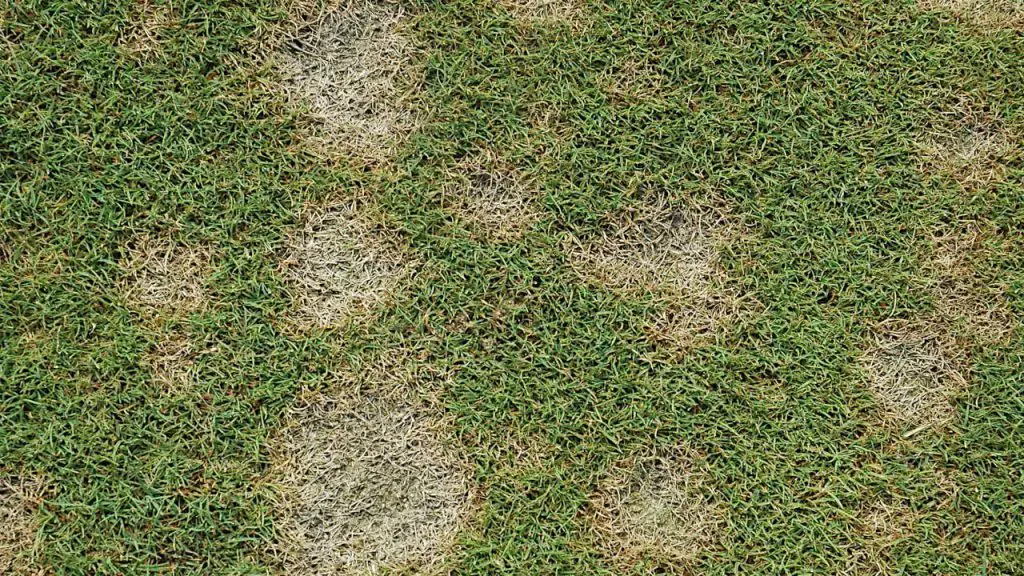
What is Dollar Spot Lawn Disease?
Dollar Spot lawn disease (Sclerotinia homoeocarpa) is a fungal disease that infects grass plants. As we have mentioned, it is one of the most common turf diseases affecting warm-season grasses. The disease is characterized by small, round, straw-colored spots. These spots generally measure between 3 and 6 inches in diameter.
Eventually, Dollar Spot infection spreads, and the patches might bleed into one another, resulting in enormous, irregularly discolored blotches that can sometimes be several feet across. On the underside of each damaged leaf blade, a distinctive pattern of straw-colored, straw-colored bands are visible over the whole blade, with reddish borders above and below each band.
The fungus that causes the disease in lawns targets the leaf blades rather than the roots or soils. It’s a pervasive disease that affects a broad range of turfgrasses, such as bentgrass, St. Augustinegrass, centipedegrass, and zoysiagrass among others.
Environmental Conditions That are Favorable for Dollar Spot Lawn Disease
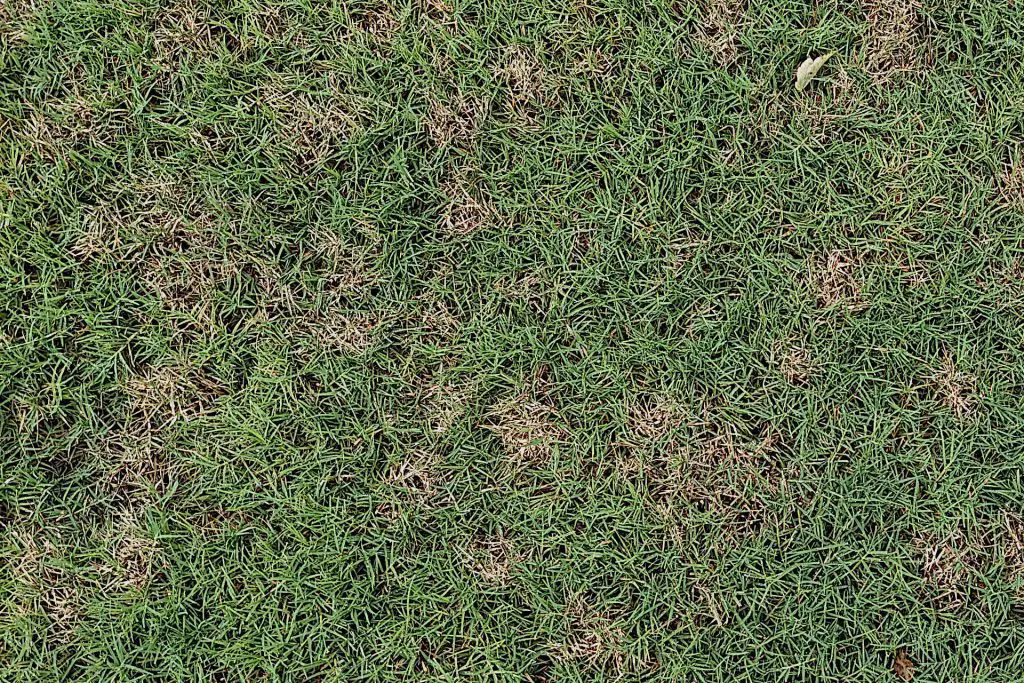
The illness tends to be found from the beginning of spring through to late autumn. Dollar Spot is most active during periods of high humidity. Daytime temperatures of 60–85°F (15–30 °C) are the most followed by chilly nighttime temperatures are the most advantageous conditions and these generally occur in spring, early summer, and late fall, respectively.
These are the conditions that are most likely to produce heavy dews and moisture is a key condition needed for dollar spot to establish itself. Despite the fact that dollar spot is far more acute in dry soils, it needs high levels of moisture in the grass to grow. The vulnerability of turfgrass to the dollar spot fungus is also increased if nitrogen levels in the soil are inadequate.
Dollar Spot Fungus Webs
Dollar spot disease is spread through the creation of a mycelium, which is when the fungus produces hyphae, a mass of branching, thread-like filaments that form the reproductive element of a fungal bacterial colony. These filaments are then mechanically transmitted from one location to another via wind or through cross-infection by machinery such as lawnmowers.
What Causes of Dollar Spot?
Dollar spot is primarily caused by high moisture warm atmospheric conditions and unintentionally poor lawn maintenance habits. The environmental climate is influential in creating conditions in which Dollar Spot can thrive The period that is particularly prevalent for the disease is the spring and late summer when the grass is susceptible to heavy dew forming. However, other important contributing factors include type of turfgrass, poor nitrogen content in the soil, and poor watering and maintenance habits.
Adverse Watering:
While you have no control over the weather, you do have control over how much water you use on your grass. Indeed with bad watering practices, you may be providing the perfect breeding habitat for dollar spot. If you overwater and the water does not penetrate deeply enough, you will end up with a situation in which the lawn is moist but the soil and the grass’s roots are dry. These are perfect conditions for the dollar spot fungus to flourish in. It is best to water your grass well every so often as opposed to watering on a too-regular basis.
Grass and Soil Health:
One of the biggest contributing factors in dollar spot establishing itself is poor soil health and specifically the lack of nitrogen in the soil. Ensuring healthy grass and soil is therefore also critical for the prevention and control of dollar spot fungus.
Another problem can be cutting the grass too short Lawns that are shorter in length will retain moisture for a longer period of time, making them more prone to developing Dollar Spot. Increase the height of your lawn mower blade to around 2-3 inches in order to avoid this.
The accumulation of thatch can be a further issue. If you see thatch piling up on your grass, this may be a sign that dollar spot is present. The growth of thatch might hinder the soil from receiving the required quantity of oxygen it requires.
Which Turfgrasses are Most Susceptible to Dollar Spot?
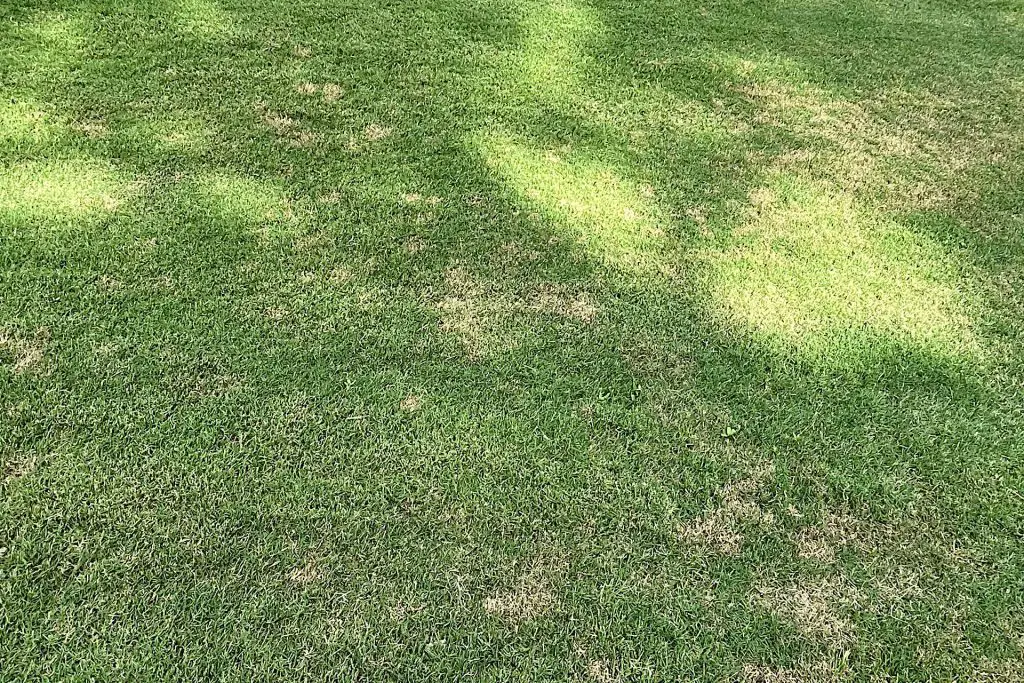
Dollar spot fungus is a pervasive disease that affects a broad range of turfgrasses, but certain varieties of grass are more susceptible to dollar spot than others. such as annual blue grasses, St. Augustinegrass, centipedegrass, and zoysiagrass among others.
Perennial ryegrass and tall fescue are among the cool-season grasses that are less vulnerable to S. homoeocarpa than other regularly utilized species, according to research. Creeping bentgrass is more sensitive to diseases than colonial bentgrass. Annual bluegrass is more vulnerable to the fungus than bentgrasses, which are more resistant.
If your location has been particularly susceptible to dollar spot, it may be worthwhile to explore switching to a grass variety that is more impervious to the disease.
How to Identify Dollar Spot Lawn Disease
In looking to identify whether your lawn has Dollar Spot there are various symptoms and warning signs to look out for. Dollar spot fungus causes distinctive patterns on the grass. They begin as little patches 2 to 6 inches across but quickly expand to form big, uneven patches on the lawn. If you get down and look at the grass blades of the affected area closely you will see that between the blades, a cobweb-like growth emerges. grass blades appear water-soaked and have yellow spots that are surrounded by a reddish border.

Older scarring on longer grass typically has an hourglass form, with the central section being smaller than the top or bottom of the scar. It is possible for individual leaf blades to have a number of minor scars or a single major lesion, or for the whole leaf blade to be injured. As lesions grow and consolidate, infected leaves become withered, becoming white to bleached yellow-colored as the dollar spot fungus spreads. Damaged leaves occur in clusters that take the appearance of round, depressed areas on the surface of the grass blade.
Dollar spot-affected turfgrass regions are often bare of foliage and infested with weed species as a result of the disease. In the early phases of the disease symptoms of dollar spot, can appear similar to those of Pythium blight, and brown patch.
Dollar Spot Disease Cycle
The mycelium of dollar spot may penetrate leaves directly, enter via cut leaf tips, or enter through stomata, all of which can result in the development of infection. The fungus secretes enzymes and poisons that cause tissue decay as a consequence of the infection.
Dollar spot lives in infected grass as mycelium or stromata, and it is more likely to be discovered in areas of thatch than in the surrounding soil. When the environment is favorable for dollar spot, mycelium develops from affected leaf tissue and spreads to neighboring grass blades, causing them to become sick as well.
Due to the fact that the fungus does not generate spores, the movement of mycelium or contaminated leaf detritus is caused by the movement of garden machinery, wind or breeze, pets, and of course people contribute to the spread of the dollar spot fungus.
Impact on Different Turfgrass Varieties
The susceptibility to Dollar Spot varies among different turfgrass varieties. Here’s a comparative analysis:
Susceptibility Rankings:
- Highly Susceptible: Bentgrass, Annual Bluegrass
- Moderately Susceptible: Kentucky Bluegrass, Fine Fescue
- Least Susceptible: Tall Fescue, Perennial Ryegrass
Specific Impacts:
Each grass type exhibits unique symptoms when infected with Dollar Spot, ranging from small straw-colored spots to larger patches of discolored turf.
Varietal Resistance:
Some grasses have inherent resistance to Dollar Spot. Breeding programs aim to enhance this trait, offering hope for more resistant turfgrass varieties in the future.
Understanding the different impacts on turfgrass varieties helps in selecting the right grass type for your lawn, leading to a healthier, more disease-resistant turf.
What kills dollar spot fungus? | Treating Dollar Spot Lawn Disease
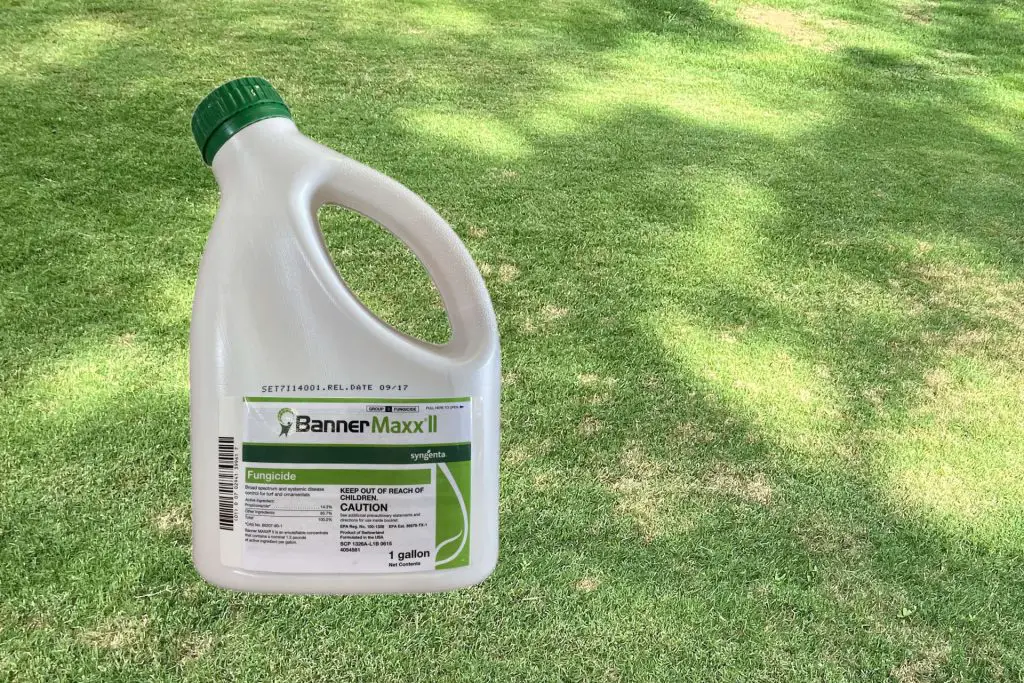
Dollar spot is a fungus, most of the time it does not require a fungicide to treat it. Dollar spot can be maintained by applying adequate nitrogen fertilization. This can be used as a preventative treatment but also encourages grass affected by dollar spot to quickly recover. However, there are occasions when you will need to use fungicides.
Will dollar spot disease go away on its own?
Dollar spot disease is unlikely to go away on its own. Indeed if left untreated it is likely to spread and infect large areas of the lawn as the fungus is easily transmissible through footfall, pets, and breeze.
It is therefore advisable to treat it and its causes as swiftly as possible to recover and maintain your lawn. This can be achieved, depending on the extent of the disease by either cultural or chemical methods.
Cultural Control (Non-Chemical)
The Dollar Spot fungus affects only plant tissue. The fungus is not parasitic and has no effect on the grass roots. This allows the opportunity for non-chemical solutions if the problem is caught early.
Cultural control is the first line of attack when looking to eradicate Dollar Spot. Maintain a healthy soil pH using high-quality nitrogen fertilizers to help keep Dollar Spot away. Water stress should be avoided. Consider scheduling watering for first thing in the morning to limit the amount of time the grass is wet. Increase the height of your mowing during hot weather to help reduce drought stress.
Chemical Control
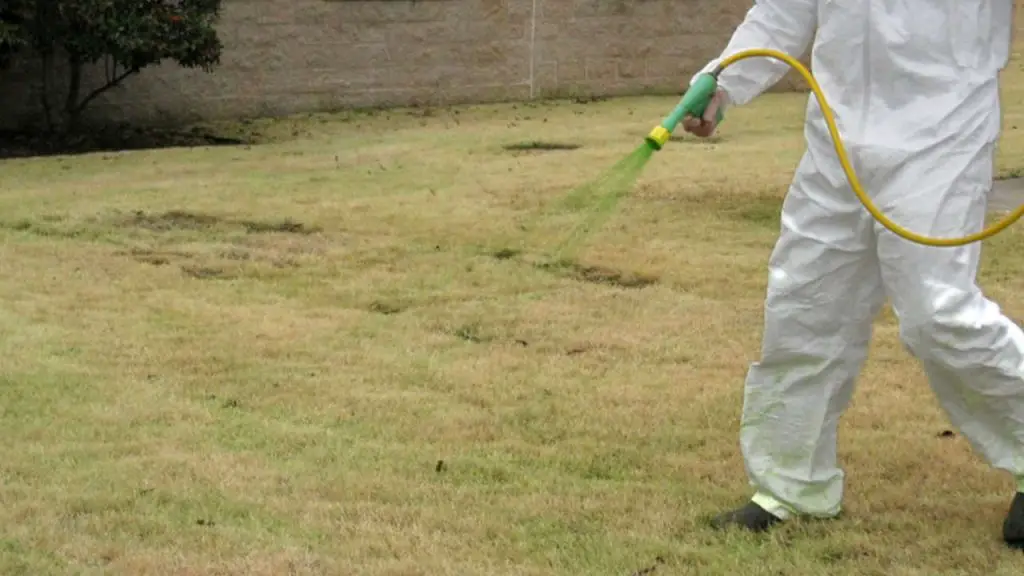
When cultural techniques are insufficient in managing the dollar spot fungus, a lawn fungicide may be applied to assist in the treatment of the disease. Early treatment, is crucial in avoiding the dollar spot fungus from growing and spreading throughout the lawn.
Treatment Options
When preventative measures fall short, treatment options step in to combat Dollar Spot. Here’s a breakdown of effective treatments:
Chemical Treatments:
- Fungicides: They are effective in controlling Dollar Spot. Some notable fungicides include Propiconazole and Chlorothalonil.
| Fungicide | Application Rate | Frequency |
|---|---|---|
| Propiconazole | 2-4 oz/1000 sq ft | Every 14-28 days |
| Chlorothalonil | 5-10 oz/1000 sq ft | Every 7-14 days |
| Boscalid | 0.9-1.2 kg ai/ha | Every 7-14 days |
| Flutolanil | 0.25 to 0.5 per 1000 sq ft | Every 7-14 days |
| Mancozeb | 1 to 2 lb per 1000 sq ft | 7-14 days |
| Fluoxastrobin | 0.125 to 0.25 lb per 1000 sq ft | Every 7-14 days |
| Azoxystrobin | 0.25 to 0.5 lb per 1000 sq ft | Every 3 to 5 days |
| Myclobutanil | 0.25 to 0.5 lb per 1000 sq ft | Every 3 to 5 days |
| Triadimefon | 0.25 to 0.5 lb per 1000 sq ft | Every 7-14 days |
| Triticonazole | 0.3-0.6 lb per 1000 sq ft | 14-28 days |
| Vinclozolin | 0.5 to 1 lb per 1000 sq ft | 7 to 14 days |
Please note application rates and frequency are a guide, please follow the manufacturer’s instructions, and if in doubt contact your local extension office or a professional lawn care specialist
Organic Treatments:
- Biological Controls: Utilizing beneficial microbes to outcompete or inhibit the Dollar Spot fungus.
Application Guidelines:
- Proper Identification: Ensure it’s Dollar Spot you are dealing with before applying any treatment.
- Follow Label Instructions: Adhering to the product instructions ensures efficacy and safety.
- Rotate Treatments: To prevent fungus resistance, alternate between different fungicide modes of action.
Selecting the right treatment and applying it correctly will significantly enhance your lawn’s ability to recover from Dollar Spot, restoring its verdant allure.
Preferred Treatments
Two of the best fungicides we find best for dealing with Dollar Spot are Boscalid and Flutolanil. These solutions though should only be considered short-term solutions as the fungus can quickly become resistant.
Other alternatives include Chlorothalonil, Propiconazole, and Mancozeb. In contrast to boscalid and Flutolanil, they have a lower probability of becoming resistant to Dollar Spot. The problem with them though is that, although this is good news for the long-term stability of both treatments, all of these fungicides are not nearly as effective as boscalid and Flutolanil.
Probably the best fungicides are propiconazole and fludioxonil. In addition to having excellent effectiveness, they also have a low likelihood of acquiring resistance to grass diseases. For want of a better phrase, these fungicides effectively destroy Dollar Spot swiftly, robbing it of the opportunity to acquire and build resistance to disease management approaches and evade them in the future. These fungicides tend to only be available to professional lawn treatment and landscaping firms, although some garden centers may be able to help.
One key takeaway from this is that overuse of the same fungicide can lead to the onset of fungicide resistance. To stop or delay this resistance to fungicides, it is good practice to rotate through different fungicides and fungicide classes such as contact fungicides and tank-mix systemic fungicides.
How to prevent dollar spot lawn disease?
It is clearly impossible to control the weather but there are many things that you can do to minimize the risk of dollar spot taking hold in the first place, especially with your lawn care regime.
Preventative Measures
Preventing Dollar Spot lawn disease requires a blend of good cultural practices and timely interventions. Here are the proactive steps you can employ to ward off this common turf menace:
Proper Watering:
Watering is a pivotal aspect of lawn maintenance. Over-watering creates a favorable environment for Dollar Spot:
- Water Deeply but Infrequently: It promotes deeper root growth and drier surface conditions, disfavoring fungal growth.
- Morning Watering: Allows grass to dry during the day, reducing prolonged moisture that favors fungus development.
Nutrient Management:
Maintaining balanced soil nutrients, especially nitrogen, is crucial for preventing Dollar Spot. Conduct soil testing to determine nutrient levels and amend the soil accordingly:
| Nutrient | Ideal Level | Amendment |
|---|---|---|
| Nitrogen | Medium-High | Slow-release fertilizers |
Mowing Practices:
The way you mow can either deter or invite fungal diseases. Here’s how to mow right:
- Mow at the Right Height: Different grass types have optimal mowing heights. Stick to them.
- Sharp Blades: Dull blades tear grass, creating openings for fungal invasion.
Thatch Management:
Thatch can harbor Dollar Spot fungus. Regular dethatching allows the soil to breathe, enhancing its ability to ward off diseases:
- Regular Dethatching: Especially in spring and fall.
- Aeration: Breaks up compacted soil and thatch, promoting better water and nutrient penetration.
Good Cultural Regimens In Practice
As mentioned Good watering practice is key as Dollar Spot thrives in wet moist humid conditions. Early morning watering (from 6:00 a.m. to 10:00 a.m.) will help prevent the grass from being excessively wet for an extended period of time. If you are having a prolonged stretch of rain, you should let Mother Nature to take handle of the watering until the weather becomes dry. It is best to water your grass well every so often as opposed to watering on a too-regular basis.
In the spring and summer months, fertilizing lawns may help to ensure a sufficient amount of nitrogen is available to the grass. It is best to use a nitrogen-rich fertilizer to achieve this. It could also be useful to have your soil checked to know what nutrients it may be deficient in.
Lightweight rolling of your lawn is another practice that has shown some benefit in reducing Dollar Spot.
In order to allow your lawn the best chance of drying out quickly, it is good, for the health of your grass, that enough air movement is allowed. Ensure that trees and bushes are properly pruned so that there is sufficient ventilation to help in the evaporation of rainwater from the ground. Once a year, you should aerate and scarify your lawn in order to improve drainage. Aside from thatch removal, scarifying also helps to reduce the amount and frequency with which plant diseases spread across the garden.
More Resistant Grass Varieties
Using Dollar Spot resistant cultivars when overseeding or turfing an area that has previously been affected, or even when turfing or seeding a new area of a lawn that has had a history of outbreaks should be taken into consideration.
Maintaining the health of your lawn by watering it sufficiently, but not overwatering, fertilizing it with nitrogen-rich fertilizer, and ensuring that it is maintained at the right height will give you healthy grass that is far less susceptible to lawn Dollar Spot and other lawn fungi such as red thread.
